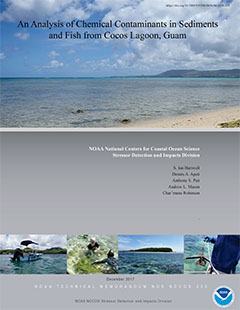-
Home
-
Data & Publications
-
Regional Portals
- About Regional Portals
- Florida
- Navassa Island
- Puerto Rico
- Flower Garden Banks
- U.S. Virgin Islands
- American Samoa
- Commonwealth of the Northern Mariana Islands
- Federated States of Micronesia
- Guam
- Main Hawaiian Islands
- Republic of the Marshall Islands
- Northwestern Hawaiian Islands
- Republic of Palau
- Pacific Remote Island Areas
-
CRCP Activities
- Glossary
An Analysis of Chemical Contaminants in Sediments and Fish from Cocos Lagoon, Guam

As part of the NOAA Coral Reef Conservation Program (CRCP) jurisdictional priority gathering, local agencies in Guam identified Cocos Lagoon as an area potentially impacted by land-based sources of pollution. The US Coast Guard operated a Long Range Navigation (LORAN) station on Cocos Island at the southern end of Cocos Lagoon from 1944 to 1963. Disposal of materials from the operation of the station are suspected of resulting in chemical contamination of the island and surrounding waters. To help address this, the NOAA/NOS National Centers for Coastal Ocean Science (NCCOS) collected sediment and fish samples for chemical contaminant analysis throughout Cocos Lagoon in May 2015, with local partners.
Results of the analysis indicated low levels of most chemical contaminants in sediments. The organochlorine insecticide DDT was somewhat elevated in sediment on the northern end of Cocos Island, exceeding a NOAA sediment quality guideline. Elevated levels of polychlorinated biphenyls (PCBs) along with the pesticide DDT, however, were found in most fish collected adjacent to Cocos Island. A number of the fish contained concentrations of both PCBs and DDT above subsistence and even recreational fisher Screening Values established by the US Environmental Protection Agency. Lower concentrations of PCBs and DDT were found in fish from other areas of Cocos Lagoon, however, some were above the subsistence Screening Value for PCBs.
Citation: Hartwell, S.I., D.A. Apeti, A.S. Pait, A.L. Mason, and C. Robinson. 2017. An Analysis of Chemical Contaminants in Sediments and Fish from Cocos Lagoon, Guam. NOAA Technical Memorandum NOS NCCOS 235. Silver Spring, MD. 74 pp.
An Analysis of Chemical Contaminants in Sediments and Fish from Cocos Lagoon, Guam: (full report, pdf 8.2 MB)
Direct questions or comments to:


